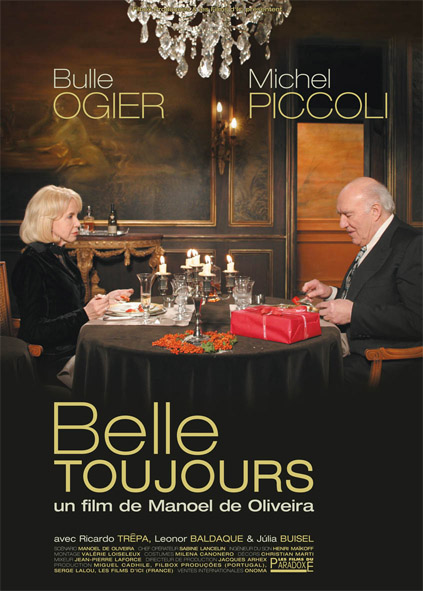ビュル・オジェ とミシェル・ピコリ、この二人が会食する。それだけで人生の光と翳りを豊かに見せることが可能であり、一本の映画になりえるはずだという確信の潔さがあまりにも見事で、ぶったまげてしまうのが、この作品である。短い、あまりにも短い。が、けっして短編とは言えない何かが漲るこの作品こそ、オリヴェイラの横綱相撲である。
ブニュエルの「昼顔」(Belle De Jour)ではドヌーブであったが、「夜顔」(Belle Toujours)ではビュル・オジェとなり、それだけでこの作品は続編としての資格を失っているという声をどこかで目にしたが、それは全く作品を見ないでのたまう人間の戯言だということを、この作品は簡単に証明している。続編とは様々なアプローチがあるが、その殆どが失敗すると運命づけられているという映画史的な抑圧を物ともせず、飄々と自分なりの恋物語を作り上げてしまう、紛れもない巨匠の演出術がそこにあるからだ。
長回しの会話劇の中で、突如人物をオフスクリーンに置いたり、音声をオフにしたりすることで映画的感性を刺激するオリヴェイラ。「家路」ではミシェル・ピコリの靴を映したショットに度肝を抜かれたが、「夜顔」ではビュル・オジェへのプレゼントを買うことになる雑貨屋の前での音が、全て町のノイズでかき消され、それが後に二人の再会へとつながるサスペンスとして機能する。こんな単純なきわまりない目隠しで、一つのドラマは成立してしまうのだ。
ジャンヌ・ダルク像や夜のエッフェル塔など、シーン・シーンの間に現れるパリの情景が、相変わらずオリヴェイラ的なとしかいえない、恐ろしい重厚さを放っており、人物の会話劇であったはずの本作が、実はそのような銅像や情景を我々の記憶に焼き付いているあたりが、さらに恐ろしいのであった。
“Belle Toujours” Manoel De Oliveira
Oliveira, the eldest cineast on earth, must have strong belief that you can make a substantially profound film only with a man and a woman — Bulle Ogier and Michel Piccoli in his new “Belle Toujours”. I was quite impressed by this simple insight that the Portuguese master has demonstrated. The length, 68 minutes, is not long at all, but you can’t call it a short film nor a medium-length one, nor a mini feature. The film carries its own gravity and meanings as cinema, that has proven the Oliveira’s master-hand.
I’ve read somewhere that it cannot be accepted as a sequel of Luis Bunuel’s “Belle De Jour” because Catharine Deneuve, the star in Bunuel’s didn’t appear in Oliveira’s. But seeing the film itself clearly defies the criticism. Oliveira’s own love story about re-encounter of an old couple was uniquely crafted with intriguing montages of eye-contacting shots during the dinner scene. Sequels are usually destined to be worse than the original, but the almost-100-year-old master has easily proven that is not the case with him.
His use of off-screen is quite stimulating as always. As he showed Michel Piccoli’s shoes in “I’m Going Home” at the most tense moment of drama, in “Belle Toujours” he rips off sound when the couple finally meet on the street and promise to meet again for a dinner. Oliveira’s mise-en-scene seems very simple and it’s shown us that a film can be made this way.
The insert shots of the Jeanne D’Arc statue and the Eiffel Tower at night beautifully decorate Paris in the film, giving the existential power to the shots. Although the film itself is driven by spoken dialogs, but what’s left in our mind is rather the statue images and the modern landscape of Paris.
夜顔 Belle Toujours

